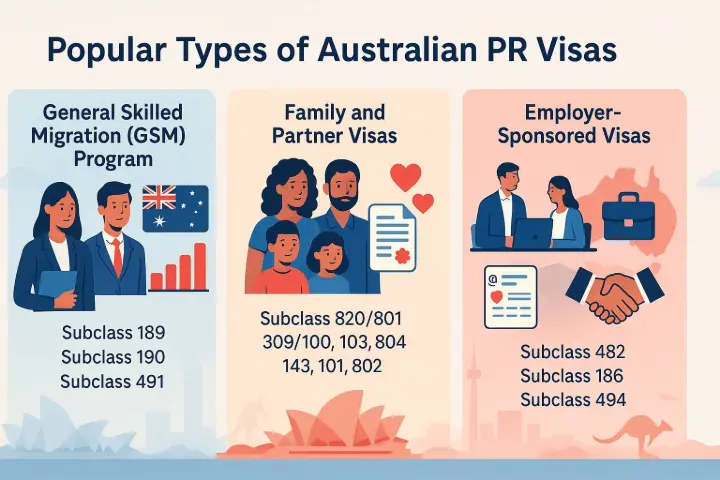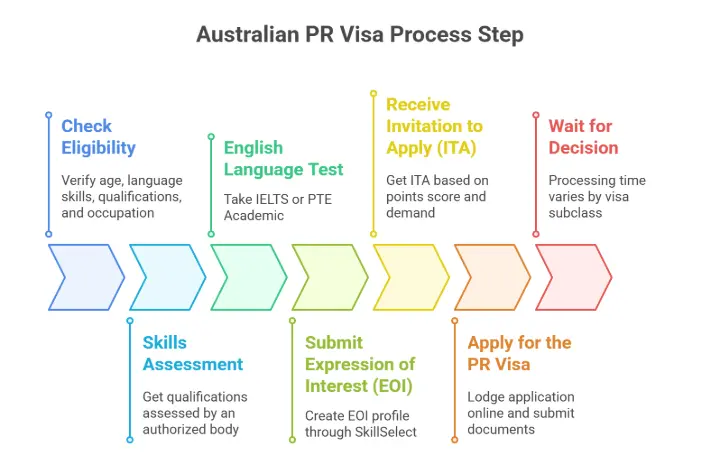Australia continues to attract thousands of individuals each year with its strong economy, high quality of life, world-class healthcare and education systems, and multicultural society.
But how do you get Australian permanent residency, and what does it take to make the move?
Whether you're a skilled worker, an international graduate, or a family member of an Australian citizen,
If you're searching for answers like:
- How to become an Australian permanent resident?
- How do you become an Australian permanent resident through study or skilled work?
- What is the process of getting PR in Australia?
- How many PR points do you need?
…you’re in the right place.
Let’s break it down so you can confidently take your next steps toward getting Australian PR and building a future in one of the world’s most livable countries.
What are the Australian Permanent Residency Requirements?
Before applying, it's essential to understand how to get Australian residency & its requirements. The Department of Home Affairs has specific Australian permanent residency requirements depending on the visa stream you're applying under.
General Requirements:
- Age: Typically under 45 years for skilled migration visas
- English language proficiency (IELTS, TOEFL, or PTE scores)
- Good health and character (health examination and police clearance required)
- Skills assessment from an authorized assessment body
- Occupation must be on the occupation list for Australia PR (MLTSSL, STSOL, or ROL)
Knowing how to become an Australian permanent resident starts with confirming whether you meet these requirements.
Popular Types of Australian PR visas

1. General Skilled Migration (GSM) Program
This is one of the most common types of Australian PR visas for skilled professionals.
- Subclass 189 visa (Skilled Independent): Does not require state or employer sponsorship.
- Subclass 190 visa (Skilled Nominated): Requires nomination by an Australian state or territory.
- Subclass 491 visa (Skilled Work Regional - Provisional): Requires regional sponsorship and leads to PR after three years.
Each of these is a points-based immigration Australia stream, where applicants must submit an Expression of Interest (EOI).
2. Family and Partner Visas
If you have a close family relationship with an Australian citizen or permanent resident, you may be eligible to apply for PR through Family or Partner visas. This is one of the most direct and reliable answers to how to become an Australian permanent resident without relying on points-based immigration.
Common Family-Based PR Visas:
- Partner Visa (Subclass 820/801 for onshore, Subclass 309/100 for offshore): For spouses or de facto partners of Australian citizens or PR holders. This is a two-stage Australian PR visa process: a temporary partner visa followed by permanent residency.
- Parent Visa (Subclass 103, 804, or contributory visas like 143): For parents of settled Australian citizens or PR holders.
- Child Visa (Subclass 101 or 802): For dependent children of eligible sponsors.
- Carer and Remaining Relative Visas: For individuals who are the last remaining relatives or are caring for someone in Australia with long-term medical conditions.
Note: These visas do not use the points-based immigration Australia system but do require strict evidence of relationships, financial dependency, or caregiving responsibilities.
3. Employer-Sponsored Visas
Employers can sponsor skilled workers through the Temporary Skill Shortage (TSS) visa, which can later lead to permanent residency.
- Temporary Skill Shortage (TSS) Visa (Subclass 482)
Valid for 2–4 years, depending on the occupation list for Australia PR STSOL/MLTSSL. Can lead to PR after 2–3 years. - Employer Nomination Scheme (Subclass 186)
Permanent residency via Direct Entry or Temporary Residence Transition Stream. - Skilled Employer Sponsored Regional Visa (Subclass 494)
For regional areas. Leads to Subclass 191 (PR) after 3 years of residence and work.
Tip: It doesn’t require points & ensures support from a sponsoring employer with a potential fast-track to permanent residency in Australia.
Tip: Occupations under high demand or critical skills shortage (e.g., healthcare, engineering, construction, IT) are more likely to receive sponsorship opportunities. View the current list of skills in demand for PR visas to align your career path accordingly.
What is the Australian PR Visa Process?
Understanding the steps to apply for Australian permanent residency helps you stay organized and avoid delays.

Step 1: Check Eligibility
Verify your age, language skills, qualifications, and whether your occupation is listed.
Step 2: Skills Assessment
Get your qualifications assessed by an authorized body based on your profession.
Step 3: English Language Test
Take a recognized test like IELTS or PTE Academic.
Step 4: Submit Expression of Interest (EOI)
Create an EOI profile through SkillSelect for points-based immigration to Australia.
Step 5: Receive Invitation to Apply (ITA)
You’ll get an ITA based on your points score and demand for your occupation.
Step 6: Apply for the PR Visa
Once invited, lodge your application online and submit documents, including health and character certificates.
Step 7: Wait for Decision
The processing time varies depending on the visa subclass and the completeness of your application.
How Many Points Are Needed for PR in Australia?
The minimum required is 65 points, but competitive applicants often score higher. If you're wondering about effective ways to improve your PR points in Australia to boost your chances, check out our dedicated guide
Criteria | Points | Details | |
Age | Up to 30 points | Applicants aged 25 to 32 receive the highest points (30). Ages 18–24 and 33–39 get fewer points. After 45, you’re not eligible for points-based PR. | |
English Proficiency | Up to 20 points | 20 points for “Superior English” (IELTS 8.0+ or equivalent). 10 points for “Proficient English” (IELTS 7.0+). No points for “Competent English.” | |
Skilled Employment Experience | Up to 20 points | More experience means more points. For example, 8+ years overseas = 15 points, 8+ years in Australia = 20 points. | |
Educational Qualifications | Up to 20 points | Doctorate = 20 points, Bachelor’s or Master’s = 15 points, Trade qualification/diploma = 10 points. | |
Partner Skills | Up to 10 points | 10 points if the partner is under 45, has a suitable skills assessment, competent English, and an occupation on the list. 5 points if the partner has competent English alone. | |
State Nomination / Regional Sponsorship | Up to 15 points | Subclass 190 state nomination = 5 points; regional sponsorship (Subclass 491) = 15 points. | |
Australian Study / Regional Study / Professional Year | Up to 15 points | Earn 5 points for completing a qualification in Australia, 5 points more for studying in a regional area, and 5 points for completing a Professional Year Program. | |
NAATI (Community Language Credential) | 5 Points |
| |
Minimum points to apply | 65 points | Scores between 80–95+ increase your chances of getting an invitation to apply (ITA) sooner. |
Getting PR as an International Student
If you are a student, it's important to know how you can visit Australia, study there & get PR.
- Temporary Graduate Visa (Subclass 485) allows you to stay and gain work experience.
- Gain relevant, skilled work experience in your field.
- Apply through the GSM pathway, often under Subclass 189 or 190.
- Ensure your field of study matches an occupation on list Australia PR.
The journey toward permanent residency in Australia for international students often begins with smart course selection and post-study work planning.
Common Mistakes to Avoid When Applying for PR
Even eligible applicants can be rejected due to avoidable errors. Avoid these pitfalls:
- Submitting an incorrect or outdated EOI
- Choosing a course or profession not aligned with the skilled migration eligibility Australia list
- Failing to meet the required English scores
- Incomplete or inconsistent documentation
- Missing deadlines after receiving the ITA
- Not consulting with the best immigration agent in Adelaide
Remember, each mistake can delay or derail your journey to become an Australian permanent resident.
Final Thoughts
We hope with this blog, you have got the answer for how to get Australian permanent residency. From student to skilled migrant, or sponsored employee to family member, there are multiple ways to become an Australian PR.
Although we understand that getting to know all these types of Australian PR visas and navigating the Australian PR visa process can feel overwhelming, with the right guidance and preparation, it’s entirely achievable.
If you are looking for professional assistance to get an Australian visa & permanent residency, our best immigration agent in Adelaide can help. Visafast Migration Consultancy is looking forward to hearing from you.
A bright future in Australia awaits.
Frequently Asked Questions(FAQs)
1. How long does it take to get Australian PR?
It typically takes 6 to 12 months after receiving an invitation and submitting a complete application. Processing times vary by visa subclass and individual circumstances.
2. How to apply for PR in Australia from overseas?
You can apply through the General Skilled Migration (GSM) program or family/employer-sponsored visas. Submit an Expression of Interest (EOI) via SkillSelect and wait for an invitation to apply.
3. How to get a PR in Australia without a job offer?
You don’t need a job offer if applying through the Subclass 189 (Skilled Independent) visa, which is a points-based immigration Australia and doesn’t require state or employer sponsorship.
4. How to get permanent residency in Australia for international students?
After studying, international students can apply for PR via the Temporary Graduate Visa (Subclass 485), gain work experience, and then apply for PR through GSM, state nomination, or employer sponsorship.
5. What is General Skilled Migration (GSM)?
GSM is a points-based immigration system for skilled workers. It includes the Subclass 189, 190, and 491 visas and requires skills assessment, English proficiency, and an EOI submission.
Disclaimer: This article is for general information purposes only and does not constitute legal or immigration advice. Immigration laws and policies may change over time, so we strongly recommend consulting a registered migration agent or legal professional before making any visa application.